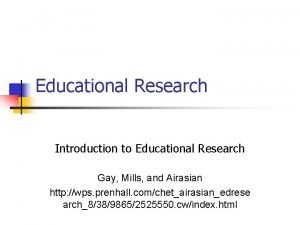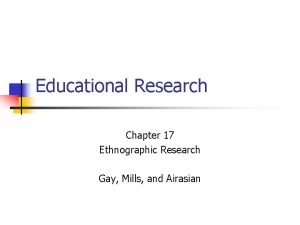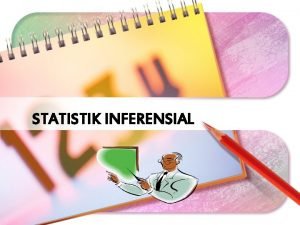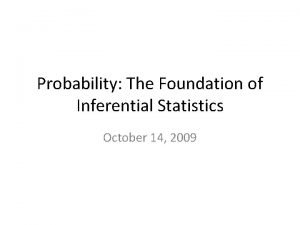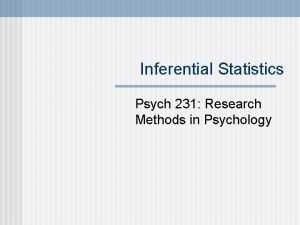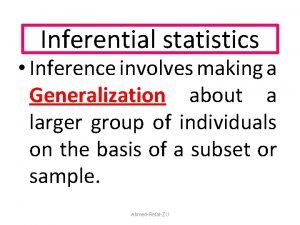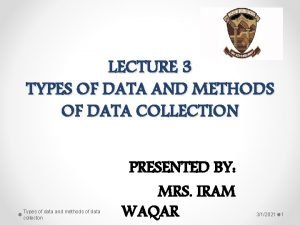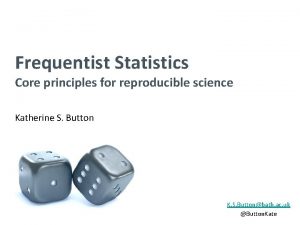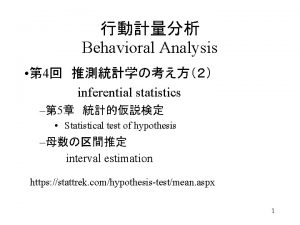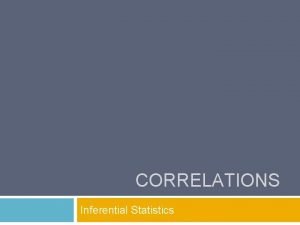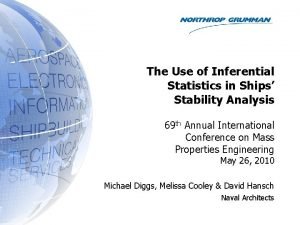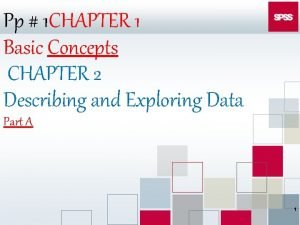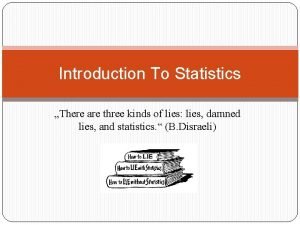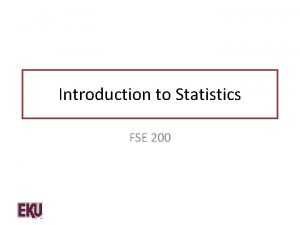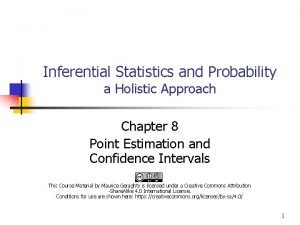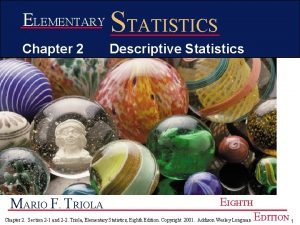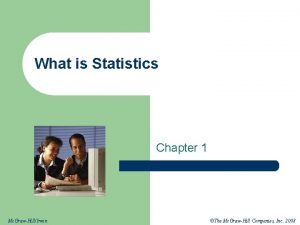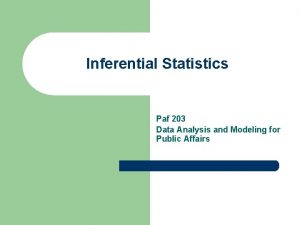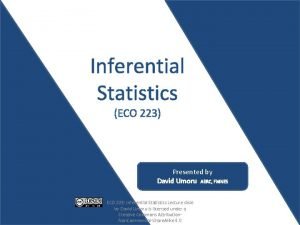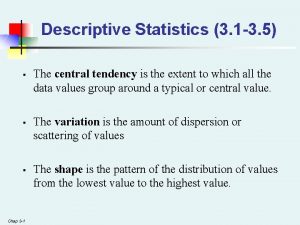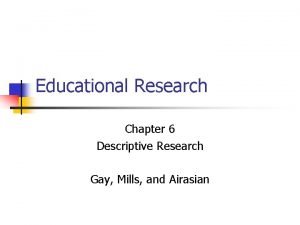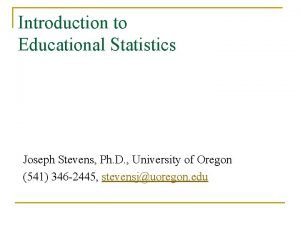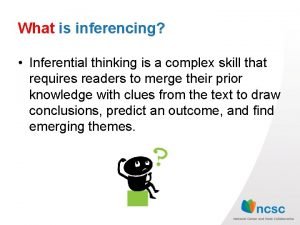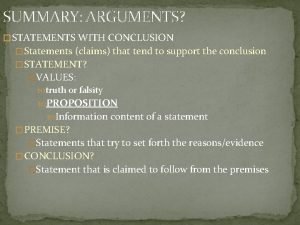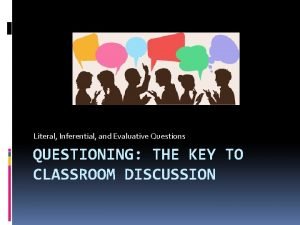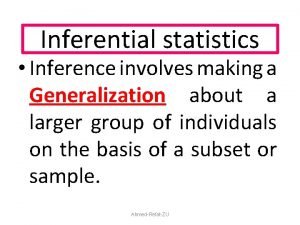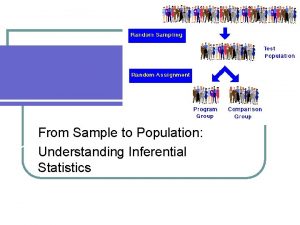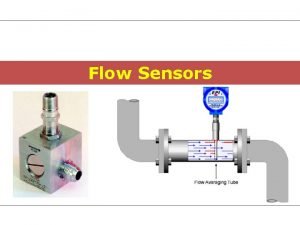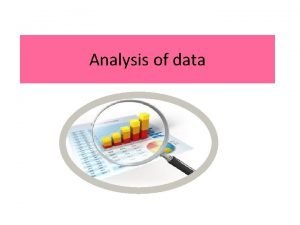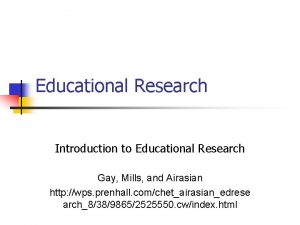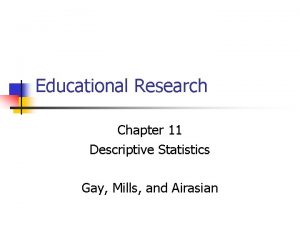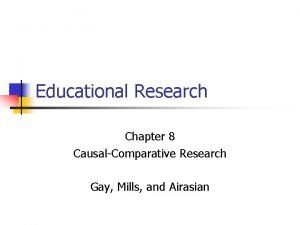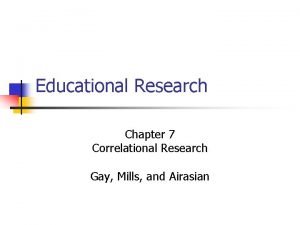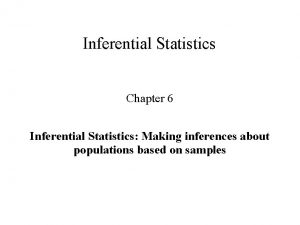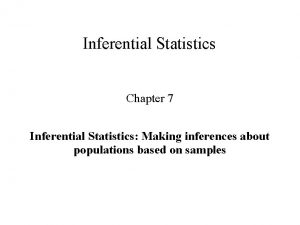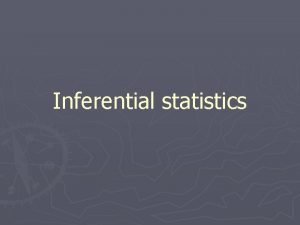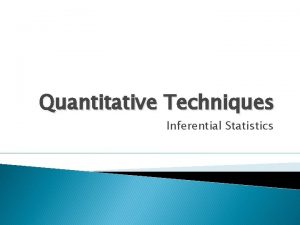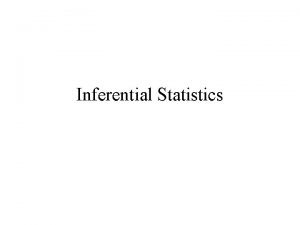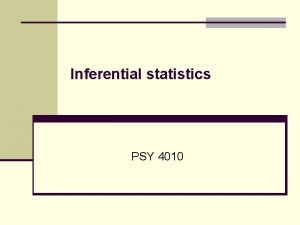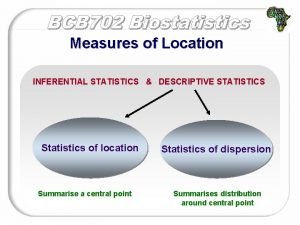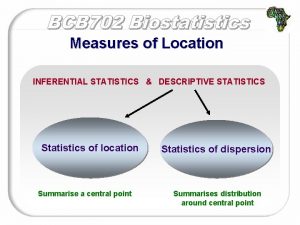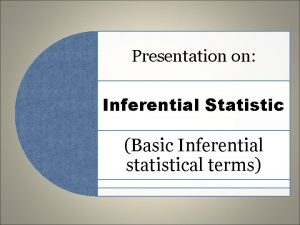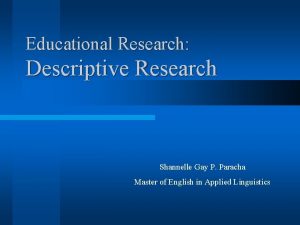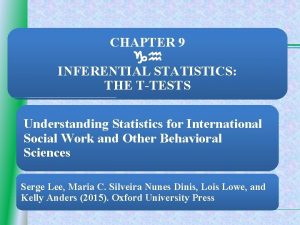Educational Research Chapter 12 Inferential Statistics Gay Mills




































- Slides: 36

Educational Research Chapter 12 Inferential Statistics Gay, Mills, and Airasian

Topics Discussed in this Chapter n n Concepts underlying inferential statistics Types of inferential statistics n Parametric n T tests n ANOVA n n n One-way Factorial Post-hoc comparisons Multiple regression ANCOVA Nonparametric n Chi square

Important Perspectives n Inferential statistics n n n Allow researchers to generalize to a population of individuals based on information obtained from a sample of those individuals Assess whether the results obtained from a sample are the same as those that would have been calculated for the entire population Probabilistic nature of inferential analyses

Underlying Concepts n n n n Sampling distributions Standard error Null and alternative hypotheses Tests of significance Type I and Type II errors One-tailed and two-tailed tests Degrees of freedom Tests of significance

Sampling Distributions n A distribution of sample statistics n n A distribution of mean scores A distribution of the differences between two mean scores A distribution of the ratio of two variances Known statistical properties of sampling distributions n n The mean of the sampling distribution of means is an excellent estimate of the population mean The standard error of the mean is an excellent estimate of the “standard deviation” of the sampling distribution of the mean Objectives 1. 1 & 1. 2

Standard Error n n Sampling error – the expected random or chance variation of means in sampling distributions The calculation of standard errors to estimate sampling error n Standard error of the mean n n Formula Dependency on sample size with n in the denominator n n The larger the sample, the smaller the standard error of the mean Standard error of the differences between two means Objectives 1. 2, 1. 3, & 1. 4

Null and Alternative Hypotheses n n The null hypothesis represents a statistical tool important to inferential tests of significance The alternative hypothesis usually represents the research hypothesis related to the study

Null and Alternative Hypotheses n Comparisons between groups n n n Null: no difference between the mean scores of the groups Alternative: differences between the mean scores of the groups Relationships between variables n n Null: no relationship exists between the variables being studied Alternative: a relationship exists between the variables being studied Objectives 3. 1, 3. 2, & 3. 4

Null and Alternative Hypotheses n Acceptance of the null hypothesis n n The difference between groups is too small to attribute it to anything but chance The relationship between variables is too small to attribute it to anything but chance n Rejection of the null hypothesis n n The difference between groups is so large it can be attributed to something other than chance (e. g. , experimental treatment) The relationship between variables is so large it can be attributed to something other than chance (e. g. , a real relationship) Objectives 3. 3 & 4. 2

Tests of Significance n n Statistical analyses to help decide whether to accept or reject the null hypothesis Alpha level n n An established probability level which serves as the criterion to determine whether to accept or reject the null hypothesis Common levels in education n . 01. 05. 10 Objectives 4. 1 & 6. 1

Tests of Significance n Specific tests are used in specific situations based on the number of samples and the statistics of interest n n One-sample tests of the mean, variance, proportions, correlations, etc. Two-sample tests of means, variances, proportions, correlations, etc. Objective 4. 1

Type I and Type II Errors n Correct decisions n n n The null hypothesis is true and it is accepted The null hypothesis is false and it is rejected Incorrect decisions n n Type I error - the null hypothesis is true and it is rejected Type II error - the null hypothesis is false and it is accepted Objectives 5. 1 & 5. 2

Type I and Type II Errors n n Reciprocal relationship between Type I and Type II errors Control of Type I errors using alpha level n n As alpha becomes smaller (. 10, . 05, . 01, . 001, etc. ) there is less chance of a Type I error Value and contextual based nature of concerns related to Type I and Type II errors Objective 5. 3

One-Tailed and Two-Tailed Tests n One-tailed – an anticipated outcome in a specific direction n Two-tailed – anticipated outcome not directional n n Treatment group is significantly higher than the control group Treatment group is significantly lower than the control group Treatment and control groups are equal Ample justification needed for using one-tailed tests Objectives 7. 1 & 7. 2

Degrees of Freedom n n Statistical artifacts that affect the computational formulas used in tests of significance Used when entering statistical tables to establish the critical values of the test statistics

Tests of Significance n Two types n n Parametric Nonparametric

Tests of Significance n Four assumptions of parametric tests n n n Normal distribution of the dependent variable Interval or ratio data Independence of subjects Homogeneity of variance Advantages of parametric tests n n More statistically powerful More versatile Objectives 8. 1 & 8. 2

Tests of Significance n Assumptions of nonparametric tests n n n No assumptions about the shape of the distribution of the dependent variable Ordinal or categorical data Disadvantages of nonparametric tests n n n Less statistically powerful Require large samples Cannot answer some research questions Objectives 8. 3 & 8. 4

Types of Inferential Statistics n Two issues discussed n n Steps involved in testing for significance Types of tests

Steps in Statistical Testing n n n State the null and alternative hypotheses Set alpha level Identify the appropriate test of significance Identify the sampling distribution Identify the test statistic Compute the test statistic Objectives 20. 1 – 20. 9

Steps in Statistical Testing n Identify the criteria for significance n n n If computing by hand, identify the critical value of the test statistic If using SPSS-Windows, identify the probability level of the observed test statistic Compare the computed test statistic to the criteria for significance n n If computing by hand, compare the observed test statistic to the critical value If using SPSS-Windows, compare the probability level of the observed test statistic to the alpha level Objectives 20. 1 – 20. 9

Steps in Statistical Testing n Accept or reject the null hypothesis n Accept n n n The observed test statistic is smaller than the critical value The observed probability level of the observed statistic is smaller than alpha Reject n n The observed test statistic is larger than the critical value The observed probability level of the observed statistic is smaller than alpha Objective 20. 9

Two Important Issues n Types of samples n Independent samples n n n Two or more distinct groups are measured on a single variable Groups are independent of one another Dependent samples n One group measured on two or more variables Objective 10. 1

Two Important Issues n Gain scores n n Subtracting the pretest scores from the posttest scores Serious problems with this analysis n Each subject does not have the same opportunity for “gain” n n n A person scoring close to the top of the test doesn’t have as much to gain as someone scoring in the middle of the test Low reliability ANCOVA as an appropriate analysis Objectives 13. 1 & 13. 2

Specific Statistical Tests n T test for independent samples n Comparison of two means from independent samples n n Samples in which the subjects in one group are not related to the subjects in the other group Example - examining the difference between the mean pretest scores for an experimental and control group Computation of the test statistic SPSS-Windows syntax Objectives 9. 1 & 11. 1

Specific Statistical Tests n T test for dependent samples n Comparison of two means from dependent samples n n n One group is selected and mean scores are compared for two variables Two groups are compared but the subjects in each group are matched Example – examining the difference between pretest and posttest mean scores for a single class of students Computation of the test statistic SPSS-Windows syntax Objectives 9. 1 & 12. 1

Specific Statistical Tests n Simple analysis of variance (ANOVA) n n Comparison of two or more means Example – examining the difference between posttest scores for two treatment groups and a control group Computation of the test statistic SPSS-Windows syntax Objective 14. 1

Specific Statistical Tests n Multiple comparisons n Omnibus ANOVA results n n n Significant difference indicates whether a difference exists across all pairs of scores Need to know which specific pairs are different Types of tests n n A priori contrasts Post-hoc comparisons n n Scheffe Tukey HSD Duncan’s Multiple Range Conservative or liberal control of alpha Objectives 15. 1 & 15. 2

Specific Statistical Tests n Multiple comparisons (continued) n n n Example – examining the difference between mean scores for Groups 1 & 2, Groups 1 & 3, and Groups 2 & 3 Computation of the test statistic SPSS-Windows syntax Objective 15. 3

Specific Statistical Tests n Two-factor ANOVA n n n Also known as factorial ANOVA Comparison of means when two independent variables are being examined Effects n n Two main effects – one for each independent variable One interaction effect for the simultaneous interaction of the two independent variables Objective 16. 1

Specific Statistical Tests n Two-factor ANOVA (continued) n n n Example – examining the mean score differences for male and female students in an experimental or control group Computation of the test statistic SPSS-Windows syntax Objective 16. 1

Specific Statistical Tests n Analysis of covariance (ANCOVA) n n Comparison of two or more means with statistical control of an extraneous variable Use of a covariate n Advantages n n n Statistically controlling for initial group differences (i. e. , equating the groups) Increased statistical power Pretest is typically the covariate Computation of the test statistic SPSS-Windows syntax Objectives 17. 1 & 17. 2

Specific Statistical Tests n Multiple regression n n Correlational technique which uses multiple predictor variables to predict a single criterion variable Characteristics n n n Increased predictability with additional variables Regression coefficients Regression equations Objective 18. 1

Specific Statistical Tests n Multiple regression (continued) n n n Example – predicting college freshmen’s GPA on the basis of their ACT scores, high school GPA, and high school rank in class Computation of the test statistic SPSS-Windows syntax Objective 18. 2

Specific Statistical Tests n Chi Square n n A nonparametric test in which observed proportions are compared to expected proportions Types n n n One-dimensional – comparing frequencies occurring in different categories for a single group Two-dimensional – comparing frequencies occurring in different categories for two or more groups Examples n n Is there a difference between the proportions of parents in favor of or opposed to an extended school year? Is there a difference between the proportions of husbands and wives who are in favor of or opposed to an extended school year? Objectives 19. 1 & 19. 2

Specific Statistical Tests n Chi Square (continued) n n Computation of the test statistic SPSS-Windows syntax n n One-dimensional uses Nonparametric Tests procedures Two-dimensional uses Crosstabs procedures Objectives 19. 1 & 19. 2
 Does qualitative research have hypothesis
Does qualitative research have hypothesis Educational research gay
Educational research gay Gay nnn
Gay nnn Tony mills gay
Tony mills gay Pengertian uji t test
Pengertian uji t test What is the foundation of inferential statistics?
What is the foundation of inferential statistics? Inferential statistics psychology
Inferential statistics psychology Inferential generalization
Inferential generalization Descriptive hypothesis
Descriptive hypothesis Rare event rule for inferential statistics
Rare event rule for inferential statistics Data collecton
Data collecton Inferential statistics
Inferential statistics Inferential testing
Inferential testing Inferential statistics correlation
Inferential statistics correlation Advantages of inferential statistics
Advantages of inferential statistics Characteristics of inferential statistics
Characteristics of inferential statistics Inferential statistics ap psychology
Inferential statistics ap psychology Types of statistics
Types of statistics Characteristics of inferential statistics
Characteristics of inferential statistics Characteristics of inferential statistics
Characteristics of inferential statistics What are class limits in statistics
What are class limits in statistics Inferential statistics definition
Inferential statistics definition Inferential statistics examples
Inferential statistics examples Inferential statement of the problem example
Inferential statement of the problem example Descriptive analysis means
Descriptive analysis means Gay 2012 descriptive research
Gay 2012 descriptive research Introduction to educational statistics
Introduction to educational statistics Introduction to statistics what is statistics
Introduction to statistics what is statistics Complex inference
Complex inference Simple non inferential passages
Simple non inferential passages Literal questions
Literal questions Null hypothesis
Null hypothesis Defective decision making
Defective decision making Inferential test types
Inferential test types Inferential type flow meter
Inferential type flow meter What is the purpose of critical listening?
What is the purpose of critical listening? Inferential ststistics
Inferential ststistics

